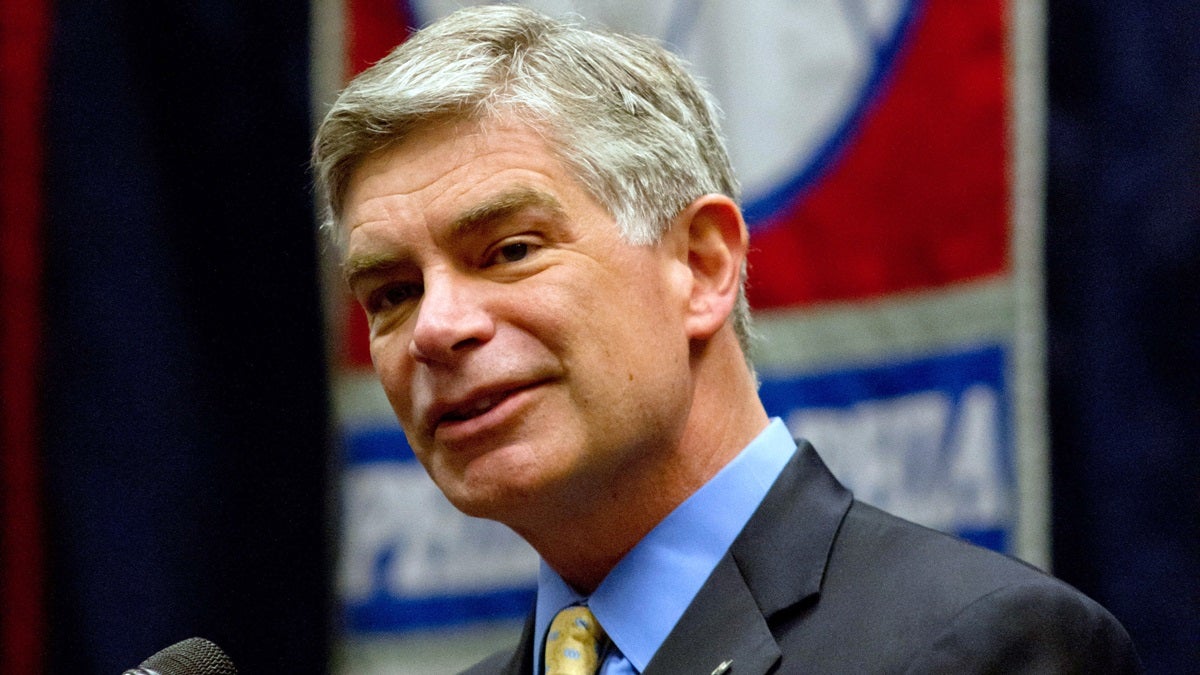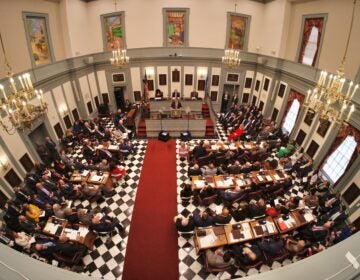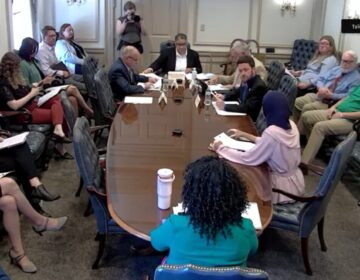Evaluating Patrick Harker’s legacy at UD

FILE - In ths April 27, 2013 file photo, University of Delaware President Patrick Harker speaks in Newark, Del. Harker has been selected to be the new president of the Federal Reserve Bank of Philadelphia. The bank’s board of directors says Patrick T. Harker, 56, will succeed Charles Plosser, who retired on March 1. Harker will take over on July 1. (AP Photo/Saquan Stimpson, File)
The search has begun for the 27th president of the University of Delaware. Doug Rainey offers some thoughts.
Here is Doug Rainey’s commentary:
It will be a while before we can fully evaluate the impact of outgoing University of Delaware President Dr. Patrick Harker.
Harker will leave Newark this summer to become president of the Federal Reserve Bank of Philadelphia.
But as the clock ticks down on a nearly eight-year stint at Hullihen Hall, it is clear that Harker transformed the university. What that will mean for his successor is the biggest question.
Harker came to Newark after serving as dean of the word-renowned Wharton School at the University of Pennsylvania. As head of what is arguably one of the top three business schools, Harker worked to build the Wharton brand on a national and even worldwide level.
Harker could have come to Newark with thoughts of retiring from the post or waiting for a presidential slot to open up at an Ivy League university.
Instead, Harker, an engineer by education and background, came with the restlessness of a Wharton-educated CEO looking for opportunities in a global marketplace.
His predecessor David Roselle had given Harker room to maneuver, building a solid financial foundation for the university. That gave Harker the luxury of pursuing his vision.
Harker brought in new administrators, with an entrepreneurial outlook. Taglines, logos and branding campaigns were launched.
A Path to Prominence strategy was undertaken that based on enrollment figures, seems to be working as students and parents continue to see UD as an attractive option to private college tuition.
In the early going, Harker talked with individual departments and students about his vision. By some accounts, his vision did not always sit well with faculty members who weren’t comfortable with his Wharton ways.
Expanding UD’s campus
Even when the economy went into a tailspin, Harker and his team moved aggressively, snapping up the sprawling Chrysler assembly plant across the street from the UD athletic complex.
The site is now the site of the Science, Technology and Advanced Research (STAR) Campus, a partnership between UD and developer Delle Donne Associates.
Meanwhile, an engineering and science laboratory was given the green light in spite of a nearly $130 million price tag. The lab was seen as a critical need in maintaining the university’s standing as a top research center.
It was on a distant corner of the new STAR campus that a combination data center and natural gas-fired power plant was quietly proposed. That project would prove to be Harker’s biggest headache.
Opposition, some of it coming from inside the vast UD community, portrayed the power plant as a dangerous, polluting beast, voicing their claims with protests, seemingly endless Newark City Council meeting testimony and embarrassing demonstrations when parents and prospective students were on campus.
With a restless faculty and townspeople questioning the project, a university committee recommended a halt to the project and the lease was terminated last year with start-up company Data Centers, Inc.
A lawsuit has been filed by Data Centers, with some suggesting that the university may not have an airtight case when it came to ending the lease.
Harker’s sports decisions
Athletics were another issue that seemed to bedevil Harker. A decision to drop the beloved men’s track program left many alumni bitter. Harker also focused on the bottom line when it came to football, even though he had played at the University of Pennsylvania.
Long rumored plans for a new or renovated stadium, perhaps at the Chrysler site, were placed on the back burner and season ticket-holders became upset as bigger contributors were given more perks.
Coach K.C. Keeler was dismissed after the team went into a slump. UD star and Super Bowl winning quarterback Joe Flacco, one of UD’s wealthiest grads, did not like the move and has rarely been seen in Newark ever since.
It turned out that an increasingly market-driven UD had determined that football was not a top priority with students. Indeed, the Blue Hen season ticket base has a large number of fans who never attended UD.
College costs
Of late, Harker has been focused on what he saw as an unsustainable pattern of tuition increases needed to support a university cost structure burdened by expensive physical plants and centuries-old practices.
The financial burden on parents and students is increasing with five and even six-figure student loans becoming commonplace.
In an opinion piece in the Philadelphia Inquirer, Harker bluntly stated that “America’s universities are pricing themselves out of the reach of the middle class.”
His comments upset many faculty members, some of whom publicly praised Harker’s decision to step down.
It was also well known on campus that Harker was not shy about speaking up on issues that are often taboo in faculty circles, one example being productivity of some faculty.
It did not help that Harker noted that he sits on the advisory board of Minerva. The college start-up that has raised tens of millions of dollars with a curriculum that has students spending their undergraduate years in online study and cultural immersion while living in San Francisco, Buenos Aires, London and other cities.
The education comes at a cost that could be a bit less than fees and housing for a non-resident student at the Newark campus and tens of thousands less than Ivy League tuition.
For now, fears that Harker could bring some features of Minerva to Newark have been quieted. Low-cost private competitors abound. Nearby Wilmington University is rapidly gaining enrollment with a lower-cost business model.
Harker’s successor may well face a far more competitive environment that could drastically change higher education and an institution deeply ingrained in the daily life of the First State.
Faculty members, longing for a return to the UD of the past, may want to keep that in mind.
———————
Doug Rainey is the editor of the Delaware Business Daily. Email Doug at drainey@delawarebusinessdaily.com This e-mail address is being protected from spambots. You need JavaScript enabled to view it or follow him on twitter: @DelBizBulletin
WHYY is your source for fact-based, in-depth journalism and information. As a nonprofit organization, we rely on financial support from readers like you. Please give today.




